Tracing the tangled tracks of humankind’s evolutionary journey
Hannah Devlin Science correspondent
The path from ape to modern human is not a linear one. Hannah Devlin looks at what we know – and what might be next for our species.
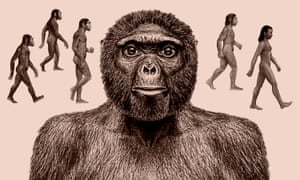
Our ancestry is still not entirely clear, although there is strong evidence for specimens such as Ardipithecus ramidus, centre, being a direct ancestor or very close to our lineage. Illustration: Getty, Guardian Design Team
Let’s go back to the beginning. When did we and our ape cousins part ways?
Scientists are still working on an exact date – or even a date to within a million years. Like many of the big questions in human evolution, the answer itself has evolved over the past few decades as new discoveries, techniques and technology have provided fresh insights.
Genetics has proved one of the most powerful tools for time-stamping the split with our closest living relative, the chimpanzee. When our complete genomes were compared in 2005, the two species were found to share 98% of their DNA. The differences hold important clues to how long our lineages have been diverging. By estimating the rate at which new genetic mutations are acquired over generations, scientists can use the genetic differences as a “molecular clock” to give a rough idea of when the split occurred. Most calculations suggest it was between four to eight million years ago.
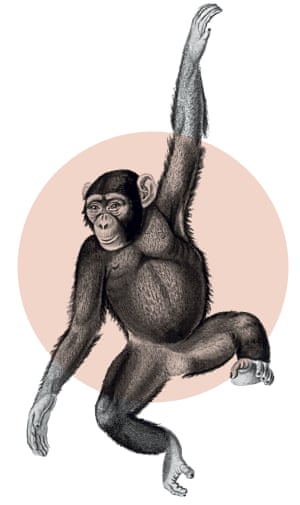
We share 98% of our DNA with chimpanzees. Illustration: Getty, Guardian Design Team.
This time window is more recent than was originally thought. In the 1960s, fossil evidence led palaeontologists to conclude that a 14m-year-old ape, Ramapithecus, was the earliest ancestor on the human line, based on the shape of its jaw. Subsequent DNA analysis has revealed the split occurred long after that – Ramapithecus is now considered an orangutan ancestor.
So are scientists still looking for the “missing link” between us and other ape species?
We still don’t know the identity of our most recent common ancestors with chimpanzees. But scientists tend to dislike the phrase “missing link”, as it implies that evolution proceeds in an orderly, linear fashion with well-defined junctures.
“It gives the sense that there is a single transitional form that magically bridges the gap between a living ape and a living human and suggests we’ve got to fit everything into our line of evolution,” says Chris Stringer, head of human origins at the Natural History Museum.
The reality is messier: different branches evolve at different rates; new traits can emerge several times independently; splits can be dragged out over millennia and across continents, with populations diverging and then interbreeding again. Rather than the tree of life it’s more like a dense, thorny bush.
But can we assume that our last shared ancestor with other living apes was something like a chimp?
Not necessarily – chimps are not simply unevolved versions of us. Our hypothetical common ancestor would have had a mixture of chimp-like traits, human-like traits and primitive traits that both species eventually left behind. The common ancestor might have walked on all fours, or might have been more upright.
Scientists are still trying to piece together this evolutionary jigsaw puzzle based on a shifting cast of creatures that show up in the fossil record. To complicate things, most of the fossils found probably represent evolutionary side-branches rather than direct ancestors.
What are some of the important fossils I should know about?
One of the earliest specimens that people believe lies on our lineage – or not far from it – is Sahelanthropus tchadensis, a six to seven-million-year-old fossil found in Chad. It has an ape-like sloping face, prominent brow and very small brain, but small human-like canine teeth. The spinal cord is positioned underneath the skull, rather than towards the back, which some say suggests the creature walked on two legs, but it’s hard to know for sure, since there’s just a skull and a few bones to go on.
Another fossil from around the same period found in Kenya, called Orrorin tugenensis (nicknamed Millennium Man), also features small teeth and a leg bone that indicates primitive bipedalism.
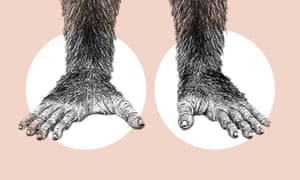
Slightly later, at 4.4m years, there is Ardipithecus ramidus (Ardi), a stunningly complete female skeleton found in Ethiopia. Ardi, who had a stocky frame and stood almost four feet (one metre) tall, had gangly ape-like arms and grasping big toe, suggesting she would have been an agile climber. Scientists are divided on the extent to which Ardi walked upright – some say she would have walked on two legs routinely, others think she would have just about managed it if she needed to use her arms to carry something. The pelvis bones are crushed and the skeleton does not include a knee, which could have helped resolve the question more definitively. The strongest evidence for Ardi being a direct ancestor, or very close to our lineage, comes from her teeth, which were small and stubby – more like modern human teeth – and lacked the large fang-like canines of chimpanzees, gorillas and earlier extinct apes.
Then comes “Lucy”, a 3.18m-year-old skeleton, named after the Beatles song Lucy in the Sky with Diamonds, the soundtrack to the 1974 excavation. Lucy is viewed as one of the most important discoveries in palaeontology as she is a unique amalgam of primitive features – a chimpanzee-sized brain, a powerful jaw and long, dangling arms – and incredibly human ones. In particular, her legs, knee and pelvis are strikingly similar to our own anatomy, suggesting that by this point our ancestors had gained the distinctive human abilities of being able to walk and run.
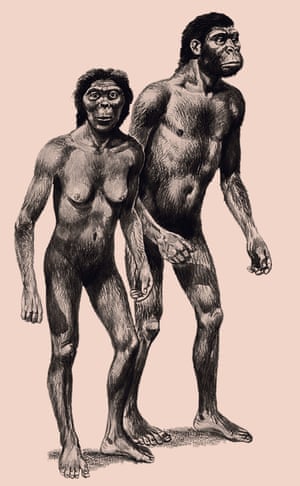
Lucy also helped cement a growing acceptance of Africa as the cradle of humanity, reflected in her species’ scientific name: Australopithecus afarensis. Scientists now think that the australopithecine genus (in the taxonomical hierarchy, genus is one up from species) gradually evolved and spread across southern and eastern Africa – and that one of these species seeded the next phase of our evolution.
Why did our ancestors start walking upright?
The traditional “savannah theory” held that shifts in the climate led to dense forests being replaced by sweeping grasslands, creating a new incentive for being able to travel long distances by foot. Yet the transition towards bipedalism appears to have started at least six million years ago – long before the African climate dried out enough to create savannahs. To complicate matters further, a recent analysis of the Lucy fossil suggests that multiple fractures had been sustained shortly before her death, leading some to speculate that she may have died falling out of a tree.
A more recent idea is that bipedalism first emerged in the forests, which would be consistent with the fossil record and may also have a modern-day parallel. Orangutans in Sumatra have been observed moving through the forest canopy by walking along branches on two legs while using their arms to help support their weight or hang, allowing them to move through thinner branches than would otherwise be possible.
Whatever prompted our transition from four legs to two, it seems to have happened over millions of years, probably with a long period of travelling between the ground and the trees.
So once we got the hang of walking, what happened next?
The boundary for when our ancestors started counting as human is blurry and somewhat subjective, but scientists place the starting point at species that emerged about 2.4m years ago, which are designated to the Homo genus. We are the sole survivors of this group, but the Earth was once home to a surprising diversity of humans, some of whom crossed paths with our own ancestors.
One of the earliest of these is Homo habilis, who lived in Africa between 2.4m and 1.4m years ago. The name means “handyman” because this species was originally thought to represent the first maker of stone tools (since then, sharpened stones, hammers and anvils dating to 3.3m years ago have been discovered). Homo habilis was short (between one and 1.4 metres or 3ft 4in – 4ft 5in) had a protruding face and massive teeth – earning one fossil the nickname Nutcracker Man. His braincase was about 50% bigger than that of the Australopithicenes, but still only half as big as a modern human’s.

Mastery of fire and cookery may have influenced changes in jaw shape. Illustration: Getty, Guardian Design Team
Homo erectus, 1.7-1.8m years ago, was much closer to modern humans anatomically. He was taller (1.5 to two metres or 4ft 9in – 6ft 1in) and bigger-brained than Homo habilis and had a far smaller jaw and teeth, implying a change in diet. Harvard anthropologist Richard Wrangham argues that the striking change in jaw anatomy suggests Homo erectus mastered fire and began cooking, allowing more efficient foraging and digestion, freeing up energy to fuel a larger brain. Homo erectus has sometimes been called the first cosmopolitan, due to the impressive geographical range it spanned, with fossils found in Africa, Spain, Italy, China and Indonesia.
The earliest evidence of Homo sapiens (that’s us) comes from fossils dated to just over 300,000 years ago excavated from a cave in Morocco. The bones of at least five people were found alongside tools, gazelle bones and lumps of charcoal. Jean-Jacques Hublin, a scientist at the Max Planck Institute for Evolutionary Anthropology in Leipzig who excavated the fossils, told the Guardian last year: “The face of the specimen we found is the face of someone you could meet on the tube in London.”
When did humans leave Africa and spread across the globe?
Until recently, converging lines of evidence from fossils, genetics and archaeology suggested that modern humans first spread from Africa into Eurasia about 60,000 years ago. However, a series of recent discoveries – including a trove of 100,000-year-old human teeth found in a cave in China, and a nearly 200,000-year-old jawbone in northern Israel – show that Homo sapiens was venturing across the world far earlier than once thought.
However, these early exits appear to have contributed very little to the genetics of modern day populations – perhaps these groups died out or were killed off by subsequent migratory waves. By triangulating the common ancestors of modern day populations, scientists can show that the ancestors of African and non-African people alive today converge at around 60,000 years ago. As these ancestors travelled across continents they would have encountered a motley assortment of other archaic human species, including the Neanderthals in Eurasia, the Denisovans in Siberia, possibly a dwarf species known as “the hobbit” (Homo floresiensis) on the Indonesian island of Flores and probably other species that we do not yet know about.
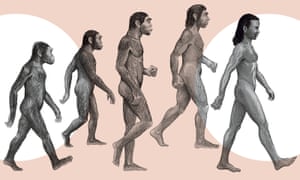
Did we kill off the Neanderthals?
Neanderthals tend to be cast as the low-browed thugs of the prehistoric world, who stood little chance against the superior intellect and hunting prowess of our own ancestors. This may be a case of unfair stereotyping, though. Neanderthals had bigger brains than us, they made jewellery, buried their dead in ancient ceremonies and used pigments – possibly for tribal markings.
It is true, however, that the Neanderthals went into a steep decline around 40,000 years ago, at a time when Homo sapiens from Africa were settling in Eurasia. Perhaps they were struggling to compete for resources, were killed in conflicts or were simply less well adapted to changes in climate that led our own ancestors to move north and east.
There’s a postscript to this story. While the Neanderthals died out as a species, in one sense they are still around today. Interbreeding between modern humans and Neanderthals means that all non-Africans alive today carry about 1-5% Neanderthal DNA. Everyone has acquired slightly different parts of the Neanderthal genome and so collectively there is a substantial fraction (at least 20%) of the Neanderthal genome spread through the living human population.
Wait … we interbred with another species?
Yes, genetics shows that the ancestors of everyone outside of Africa interbred with Neanderthals, probably more than once. There was also interbreeding with another archaic group called the Denisovans. We don’t know much about what these other ancient cousins looked like as their fossils are so fragmented. But from a finger bone found in a cave in Siberia, scientists were able to extract high quality DNA belonging to a Denisovan girl who lived about 41,000 years ago.
Intriguingly, Denisovan DNA shows up only in modern day Indigenous Australians and Papua New Guineans, suggesting that their ancestors must have met the Denisovans on their way across the globe, probably somewhere in south-east Asia.
We can only speculate on the circumstances of these interbreeding events and whether they were peaceful mergers of different tribes or violent encounters.











